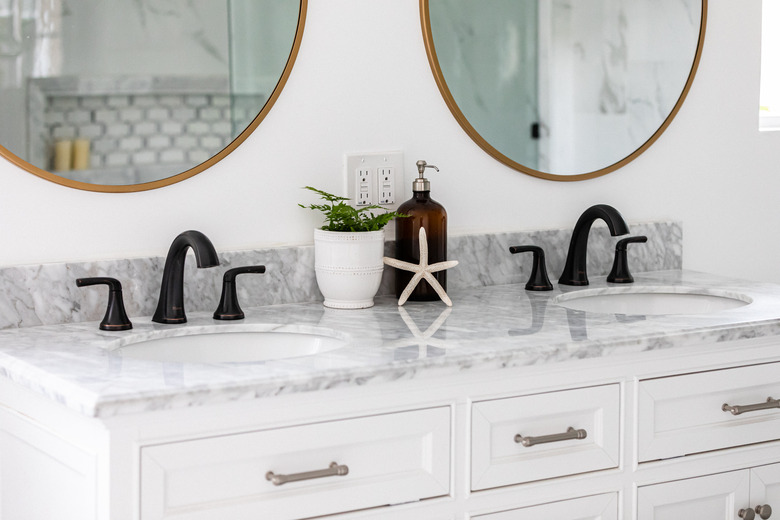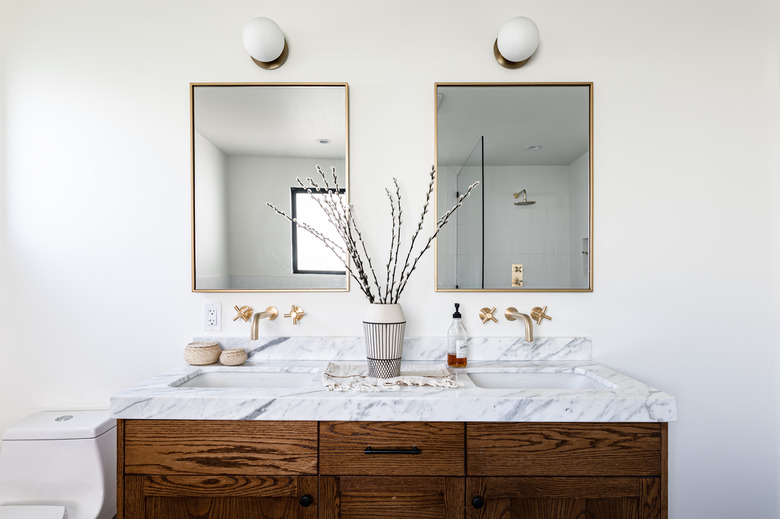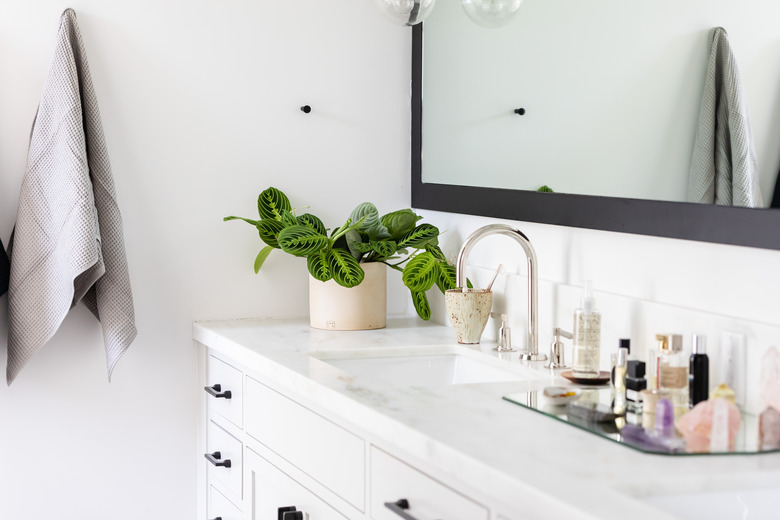Cultured Marble Vanity Tops: A Homeowner's Guide
We may receive a commission on purchases made from links.
A cultured marble vanity top is a low-maintenance alternative to a marble or granite counter, and it is especially well suited for the bathroom. This engineered material is inexpensive and a good choice for DIY enthusiasts because it's easy to install. Cultured marble may not be the perfect match for every bathroom, but overall, it performs very well and can be a solid choice in the right space.
About Cultured Marble
About Cultured Marble
Cultured marble is a type of cast polymer, which simply means it is man-made from a blend of different natural and synthetic materials that are poured into a mold and then hardened. According to the International Cast Polymer Association, cultured marble products are made of a mixture of polyester resin, catalyst, pigments and fillers, along with a clear gel coat that is designed to be the finish on the vanity top. This coating both protects the vanity and makes it waterproof. It has veins like natural marble, but they are man-made.
Although cultured marble is sometimes used for shower pans or other applications, it is most often used for bathroom countertops. As an engineered material, it offers a more nonporous surface than natural stones, much like similar man-made materials such as granite composites, quartz and solid-surface countertops. Both quartz and solid-surface materials provide more durability, but they also reflect that fact in the price point. There are many different choices for those who are interested in cultured marble for a sink vanity.
Store-Bought or Custom Cultured Marble
Store-Bought or Custom Cultured Marble
There are two main channels for purchasing a cultured marble bathroom vanity top. The first is through a home improvement or specialty store. Many places have options for DIY homeowners who are looking for an option that comes in a predetermined, standard size. Sometimes, these cultured marble tops even come with a vanity base for an all-in-one solution that doesn't even require a full installation. These can be a good choice and tend to be the least-expensive option. They usually come in a selection of popular colors.
Companies that create custom cultured marble tops provide many different options. Homeowners can select from a far wider range of colors, send in exact measurements and even add custom features such as a high backsplash or a double-bowl design. Before ordering, do a quick check to make sure the company has a reputation for making quality products, as the manufacturing process can vary. Another thing to look for is what type of warranty the company will provide for its products. The longer the warranty, the better.
Polished or Matte Cultured Marble Tops
Polished or Matte Cultured Marble Tops
Cultured marble vanities have come a long way since they were first introduced decades ago. These days, the process has been refined significantly so that the end results are more pleasing to the eye. While the veining still doesn't look as natural as it would on a real marble top, many of the companies that provide these vanities produce nice-looking options that complement a variety of different styles. These are not the same dated vanity tops of old. Today's cultured marble tends to be sturdier as well.
Cultured marble tops come in both polished and matte options. Although the polished ones still tend to be the more popular of the two, the matte look has increased in demand much as it has for other materials, like some of the natural stones. It provides a different type of look for the surface, and choosing one over the other is largely just a matter of visual preference.
Cultured Marble Vanity Sinks and Backsplash
Cultured Marble Vanity Sinks and Backsplash
There are two main types of sinks that are typically used for cultured marble bathroom vanities these days. The first is a molded sink, which is integrated right into the vanity design. This can be a good choice for ease of cleaning, as the bowl is a part of the counter and not a separate piece. Store-bought cultured marble sink sizes are somewhat limited, but if they are custom designed, they can range in both size and shape. In addition, some people prefer the look of an undermount sink, and this is also an option.
When shopping, be sure to evaluate the faucet spread and make sure it will accommodate the bathroom fixture. If ordering, be sure to specify the type of faucet hole so that can be included in the design. Backsplash is something else to evaluate. Some store-bought cultured marble tops may have an integrated backsplash but not all do. With a custom design, the size can be selected when ordering. Just keep in mind that an integrated backsplash can make a DIY installation more challenging when navigating the fit.
Advantages of Cultured Marble
Advantages of Cultured Marble
There are several reasons cultured marble countertops remain a popular choice for the bathroom space, not the least of which is the low cost. This material is one of the most affordable picks on the market, and it still offers a sense of style. Since the surface is fairly nonporous, it is also resistant to staining, mold and mildew, making it an ideal choice for a bathroom vanity. This material is a great pick for DIY fans on a budget, especially in lower-traffic bathroom areas.
When taken care of properly, these vanities can last for a very long time. Maintenance and upkeep are really quite simple, especially when compared to most natural stones. The ability to customize the design is another great feature of cultured marble tops. Measurements can be dialed in to meet nearly any need, and there are a multitude of design features that can be selected.
Disadvantages of Cultured Marble
Disadvantages of Cultured Marble
For all of the advantages cultured marble vanity tops provide, they still fall short as a higher-end option for this space in the home. Most people still tend to prefer materials such as granite, real marble and quartz, so it won't increase resale value in the same way these other materials would. That said, it can still be a nicer-looking pick than a plain laminate or a basic pedestal sink.
Other things to keep in mind with cultured marble vanity tops include the fact that this material isn't very heat-resistant, so it's not a good place to put a hot curling iron. The clear gel coat does provide a durable finish, but it can be scratched, and deeper scratches can be difficult if not impossible to repair. Also, over time, the sheen on this type of sink vanity can become dull.
Installation and Care of Cultured Marble Vanities
Installation and Care of Cultured Marble Vanities
The installation of a cultured marble vanity is fairly straightforward, with a few exceptions that are specific to the material. First, inspect the vanity top and make sure it is free of defects. Next, check the vanity bottom to see if it's flat and level so that the top will sit properly. Once this is done, do a dry fit to make sure the top will go in properly, and if not, gently belt-sand the edges.
Before final placement, install the drain and faucets, using silicone caulk or plumbers' putty to seal the drain. When tightening the drain, do it by hand and do not overtighten. Both of these things are important to make sure that the cultured marble does not crack. If there is an integrated backsplash, be careful with it when placing and use the silicone to secure it unless it is a free-standing vanity. As a final step, connect the drain and water lines, turn on the water and test it.
Basic maintenance is all that is required for a cultured marble vanity. Simply wipe down with a sponge or a soft cloth and a mild, nonabrasive cleaner. Keep water spots from forming by mopping up any excess water with a towel after use. Never use abrasive materials or cleaners on this type of counter, as it can remove or scratch the finish. To restore the shine of your countertop or to buff out very light scratches, American Standard recommends using automobile wax. Just make sure that it isn't abrasive.


